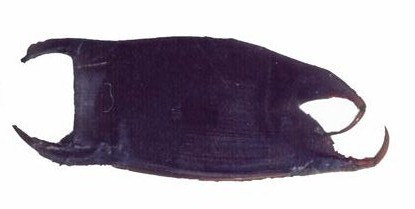Rhinoraja longicauda
Ishiyama, 1952
White-bellied softnose skate
Classification: Elasmobranchii Rajiformes Arhynchobatidae
Reference of the original description
Studies on the rays and skates belonging to the family Rajidae, found in Japan and adjacent regions. 4. A revision of three genera of Japanese rajids with descriptions of one new genus and four new species mostly occured in northern Japan. Journal of the Shimonoseki College of Fisheries, 2(2), 1–34
Studies on the rays and skates belonging to the family Rajidae, found in Japan and adjacent regions. 4. A revision of three genera of Japanese rajids with descriptions of one new genus and four new species mostly occured in northern Japan. Journal of the Shimonoseki College of Fisheries, 2(2), 1–34
Image of the original description
Image in copyright.
Image in copyright.
Types
Rhinoraja longicauda
Holotype: Reizo Ishiyama Coll.: 16737; Paratype: CAS: 23128; Reizo Ishiyama Coll.: uncat.;
Rhinoraja longicauda
Holotype: Reizo Ishiyama Coll.: 16737; Paratype: CAS: 23128; Reizo Ishiyama Coll.: uncat.;
Description :
Citation: Rhinoraja longicauda Ishiyama, 1952: In: Database of modern sharks, rays and chimaeras, www.shark-references.com, World Wide Web electronic publication, Version 12/2025
Please send your images of "Rhinoraja longicauda" to info@shark-references.com

Egg capsule of Rhinoraja longicauda MTUF 26172 (85.0 x 48.0 mm) © Hajime Ishihara, Japan

Egg capsule of Rhinoraja longicauda MTUF 26172 (85.0 x 48.0 mm) © Hajime Ishihara, Japan
Common names
 White-bellied softnose skate
White-bellied softnose skate
 White-bellied softnose skate
White-bellied softnose skate
Short Description
Lobate spines absent. Snout broad, obtuse. Juveniles greenish gray with brown hue on dorsal surface, adults chocolate-brown to gray (Ref. 41158).
Lobate spines absent. Snout broad, obtuse. Juveniles greenish gray with brown hue on dorsal surface, adults chocolate-brown to gray (Ref. 41158).
Distribution
Northwest Pacific: off northern Japan and the neighboring Russian coast. Source: www.gbif.org
Northwest Pacific: off northern Japan and the neighboring Russian coast. Source: www.gbif.org
Biology
Oviparous, paired eggs are laid. Embryos feed solely on yolk [733]. Distinct pairing with embrace. Young may tend to follow large objects, such as their mother [17086].
Oviparous, paired eggs are laid. Embryos feed solely on yolk [733]. Distinct pairing with embrace. Young may tend to follow large objects, such as their mother [17086].
Remarks
shark-references Species-ID=6087;
shark-references Species-ID=6087;
















